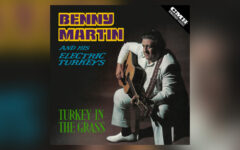 In the lyrics from the opening track (Show ‘EM Your Sermon) of his 2004 album, The Gospel In Black And White, Marty Raybon insists that your life may be the only sermon someone will ever hear. If that someone is a bluegrass fan, then the statement doesn’t hold true. You can’t listen to bluegrass for any length of time and not hear a gospel song. And what is a gospel song, other than a very short sermon?
In the lyrics from the opening track (Show ‘EM Your Sermon) of his 2004 album, The Gospel In Black And White, Marty Raybon insists that your life may be the only sermon someone will ever hear. If that someone is a bluegrass fan, then the statement doesn’t hold true. You can’t listen to bluegrass for any length of time and not hear a gospel song. And what is a gospel song, other than a very short sermon?
Homiletics has to do with the art of preaching or writing sermons, and gospel songs could certainly be studied on that basis. Dr. Richard C. Stern seems to think so.
Dr. Stern has enjoyed bluegrass music for the better part of 50 years. As a young man he was fortunate to see Flatt & Scruggs perform more than once. He played banjo in a Pete Seeger style, and a little guitar as well.
The young music enthusiast grew up to become a man of the cloth, serving as a Lutheran pastor.
But when I left the parish in 1983 to go back to graduate school I stopped playing both guitar and banjo until about 1998. So for 15 years I didn’t play anthing, but I had not played banjo for 10 years before that.
For the last 18 years this Lutheran pastor has been teaching preaching at a Catholic seminary just 35 miles north of Owensboro, KY. He began attending a few local festivals and decided it was time to pick the banjo up again, this time in the Scruggs style. Dr. Stern began taking lessons from Joe Sumner, the father of two time National Banjo Champion, Mike Sumner. He even played with a local band for a while. A few years ago the members all got to busy with work and the band disappeared. That didn’t stop Stern though, who has attended Sonny Osborne’s Banjo Retreat for the last four years, and has already registered again this year. He even plays one of Sonny’s Chief banjos. And every day Dr. Stern makes a point of picking up the instrument and picking, even if just for a few minutes.
Filling the roll of instrumentalist in the band, Dr. Stern didn’t pay close attention to the lyrics, until his theological training started to surface.
I noticed when I was playing in the band that, as a non-singer, I never paid attention to lyrics. I never was any good at memorizing lyrics. Then, because I am involved in theology, I got especially interested in the lyrics of bluegrass gospel music. So a few years ago I wrote a paper for a convention of people who teach preaching (as I do) using a method of theological analysis on a collection of Ralph Stanley’s lyrics to see if his theology was consistent across the songs he writes and also those of other composers whose songs he might sing as well. He is very consistent.
A meeting with noted bluegrass author Neil Rosenberg at IBMA, convinced Dr. Stern to adapt the paper into something that could be submitted to the Bluegrass Music Symposium at Western Kentucky University in Bowling Green, KY.
I submitted the revised paper; it was accepted; and I went down there for the conference in September 2005, I think it was. I even got my photograph in a Bluegrass Unlimited article on the Symposium. That paper was subsequently published in The Covenant Quarterly last summer. So, that first paper started out as a way to demonstrate the use of a method of theological analysis of preaching that seemed rather obtuse and complicated, but I wanted to try it with a simpler genre than sermons to see if I could get the hang of it. I thought it would be fun to apply it to the gospel lyrics. I think it worked rather well. Plus, I got to listen to bluegrass gospel lyrics all one summer and actually label it as work. I am interested also in ways of analyzing the theology evident in other cultural “artifacts.” I read and review books on pop culture and media for a journal. The method I used with the Stanely lyrics is transportable from medium to medium, genre to genre, and artist to artist. The author of the method (John McClure) adapted it from structuralist literary criticism – all of which is over my head. But he plays guitar, likes bluegrass and thought my idea was worthy.
It wasn’t long after this that Dr. Stern started noticing similarities, but also differences, in the undergirding theological framework behind the compositions of banjoist Ron Block, as compared to Stanley. Accordingly, he set out to study the two artist/composers using this same critical techniques used in his original work. Block is a prolific writer, who beyond his lyrical compositions also writes thoughtful and insightful articles on matters of Christian practice at his own website, his MySpace page, and at The Rabbit Room. All of these writings gave Stern a broad view of Block’s theological base, but he decided to make the comparison between Stanley and Block based on the lyrics of just one song written by each of them.
…the goal of my analysis was to dredge what I could from the lyrics alone and see what I got from their artifacts.
Why did I choose those two songs from Stanley and Block? In a way, it should not matter what songs I choose. The point is whether they are similar or dissimilar. To achieve any depth to the analysis, however, one should certainly look at a collection of songs by each composer. I looked at several songs for each but picked two for a little closer analysis. There are theological similarities on the surface, but I think they come from two very different situations which color the lyrics in an important way.
Stanley comes from a rural Appalachian, Primitive Baptist background, while Block comes from a southern California postmodernist, individualistic mindset. Both of these backgrounds are steeped in what Dr. Stern terms “low” church.
The church means something very different to them than it would to a Lutheran or Catholic, for example. The theology and history behind Stanley’s and Block’s perspectives, however, are quite different from one another.
It is these differences that Dr. Stern has sought to highlight in his latest writing, Bluegrass Theology: From Primitive (Baptist) to Postmodern. The paper was recently published in the Journal of Religion and Popular Culture, a web only, peer-reviewed journal focussed on exploring the “interrelations and interactions between religion and religious expression and popular culture.”
In the paper, Dr. Stern applies his knowledge of homiletics to the lyrical content of Stanley’s tune I’ll Answer the Call and Ron Block’s song, A Living Prayer.
A concern of mine with the lyrical content of gospel songs, is its faithfulness to Scripture. My question is always this: “Do the song’s lyrics reflect sound doctrine?” As Dr. Stern points out though, there are a mind boggling plethora of doctrinal stances among protestants these days, all claiming that their interpretation of the Bible is correct. Holding to a Reformed Theological conviction as I do, I have a certain lens through which I view the world. We all do. Possibly the most difficult task any student of the Bible has, is to lay aside preconceived notions and ideas, and let the Word of God speak plainly to us.
Dr. Stern’s objective here was not to delve into the minutiae of each composers theological convictions, so much as to assess their overarching theological worldview as presented in a song’s lyrics.
Using the analytical process outlined in Four Codes of Preaching, Dr. Stern compared six factors of each composer’s work. For an explanation of these factors, please read paragraph 18 of his work.
Here I’ll present Stern’s basic summary of each composers basic theological view of God and life on planet earth.
His [Stanley] view of God is of a remote God. Salvation is seen as a personal event. Endurance is one’s best, really the only, faithful option. There is no point in actively opposing evil, that is, presuming that an individual has the wherewithal to counter the efforts of evil, although neither should one surrender.
There is an optimism that pervades Block’s works, although it is not a cheery optimism. His lyrics recognize hardship and the very likely possibility of suffering, but it is more than countered by the good and by God, if we can only surrender false expectations and our persistent preference for self-direction and self-sufficiency.
The paper is quite thorough in developing these conclusions, and if you have an interest I would encourage you to read it.
The next time you listen to a bluegrass gospel tune, you might just start thinking like a theologian and considering the composer’s underlying theology.
Dr. Stern isn’t done with his analysis of bluegrass quite yet. He tells me he has begun work on a paper concerning the influence of Bill Monroe on bluegrass gospel quartets, and the theological consistency of Monroe’s gospel compositions.
We’ll be looking forward to that paper.







